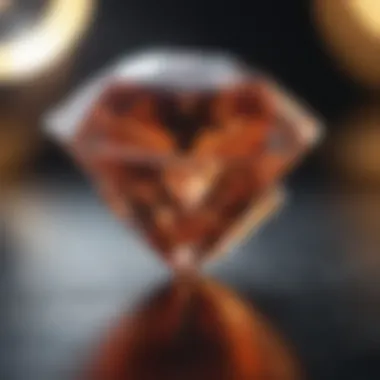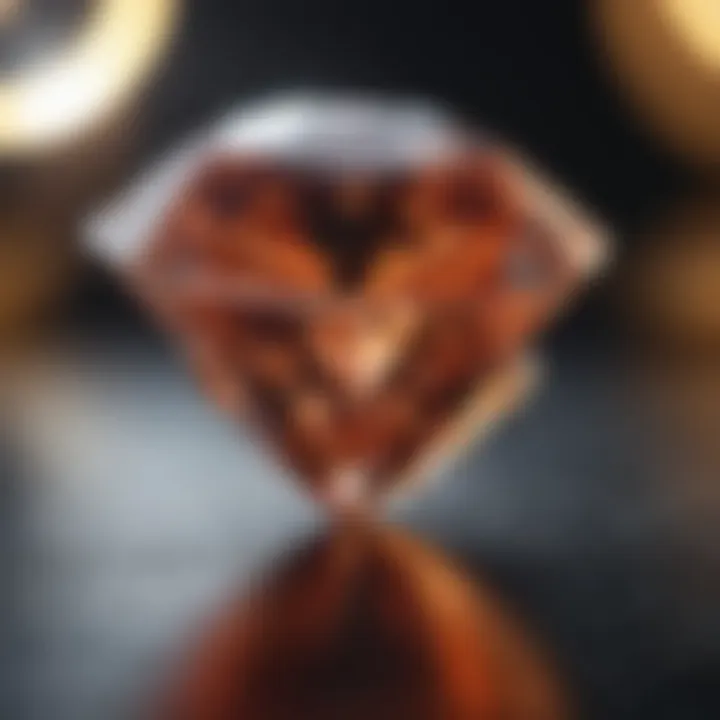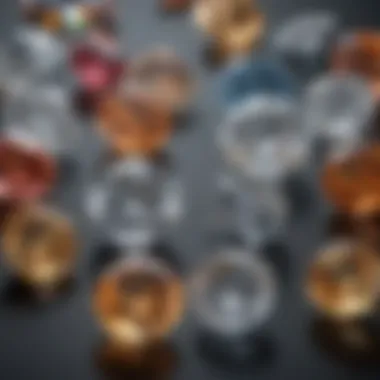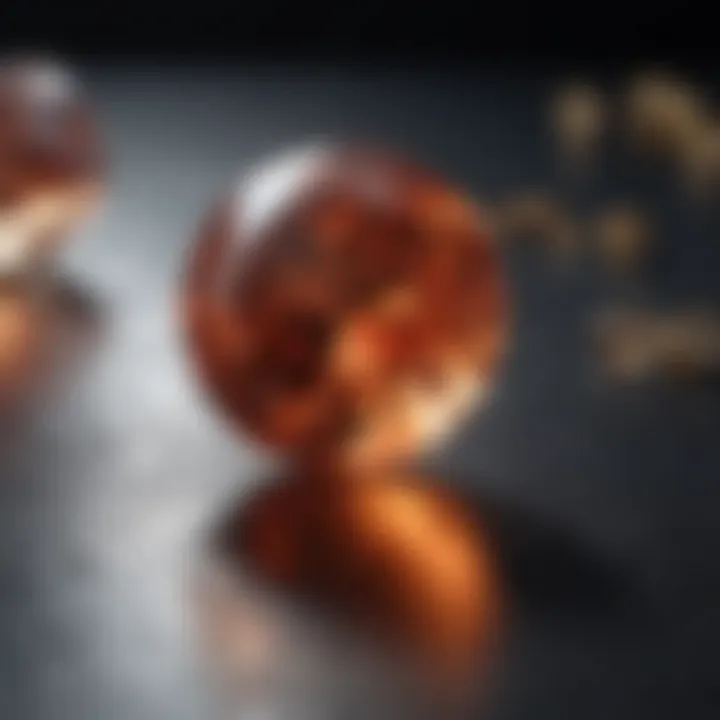Understanding GIA Diamond Grading Costs Effectively


Intro
When it comes to investing in gemstones, understanding the costs tied to GIA diamond grading is essential. The Gemological Institute of America is a beacon of trust in the realm of gemology. They offer a range of services that help buyers and sellers ascertain the quality and value of diamonds and other precious stones. Navigating the costs associated with these services can seem daunting, especially for those new to the gemstone world or for veteran collectors trying to stay current. This article serves as a compass, guiding you through the maze of GIA grading costs, elucidating the significance of these evaluations, and explaining how they influence the market.
In this exploration, we will touch upon various elements, such as laboratory charges, additional services provided by the GIA, and the intricate grading scale that should not be overlooked. With this knowledge at your fingertips, you'll be poised to make more informed decisions about your gemstone investments.
Gemstone Overview
Gemstones are not just rocks; they are nature’s masterpieces, shaped through processes that span millions of years. These precious and semi-precious stones capture human fascination, symbolizing beauty, wealth, and rarity. Understanding the basic characteristics of gemstones is fundamental to recognizing their value in a market that often hinges on precise grading.
Definition of Gemstones
A gemstone is typically defined as a mineral, rock, or organic material that is captivating in appearance and hard enough to be used in jewelry or ornamentation. By nature, they showcase a spectrum of colors, patterns, and clarity that allure collectors and enthusiasts alike.
Classification of Gemstones
Gemstones can be classified into two main categories: precious and semi-precious. Precious gemstones include diamonds, rubies, sapphires, and emeralds—generally the heavyweights in terms of value. Semi-precious stones, such as amethyst, peridot, and aquamarine, also hold their unique charm and character, often attracting buyers for their affordability and variety.
- Precious Gemstones: Known for their rarity, durability, and desirability.
- Semi-Precious Gemstones: More abundant but still exquisite, offering diverse options for collectors.
Identifying and classifying gemstones properly is crucial when considering grading costs, as the type of stone can lead to varying evaluation fees. The more sought after the gemstone, the higher the grading costs may be.
Historical Significance
The journey of gemstones is steeped in history, tracing back to ancient civilizations and their reverence towards these natural wonders. Understanding this history can deepen one's appreciation for the art of gemstone grading and the monetary value attached.
Origins of Gemstone Use
Historically, gemstones were not merely decorative. They held significant roles in cultures worldwide, often associated with power, wealth, and spiritual beliefs. Ancient Egyptians wore jewelry decorated with lapis lazuli and turquoises, believing in their protective powers against malevolent forces.
Cultural Insights: Gemstones in Ancient Civilizations
From the intricate carvings of the Indus Valley civilization to the elaborate jewelry of the Ming dynasty, gemstones have been intertwined in rituals and royal adornments across the globe. For instance, the ancients considered diamonds the tears of gods and often positioned them within talismans believed to bestow strength and clarity upon their wearers.
Understanding this rich history provides context for why gemstones are graded and why these grades have a significant impact on costs today. Their deep-rooted symbolism in human culture continues to influence the market and the perceptions surrounding their value.
"Gemstones represent the intersection of art, science, and history, and grading them accurately is a craft honed over centuries."
By delving into the past, one can better appreciate the significance of proper grading today and its costs. As we continue, we'll explore the specific details on GIA grading services and the corresponding financial implications.
Prologue to GIA Diamond Grading
In the realm of gemstones, understanding the grading process is more than just a casual endeavor; it’s a crucial piece of the puzzle for both buyers and sellers. GIA, short for the Gemological Institute of America, leads the way in this field, setting high standards in grading diamonds which plays a vital role in determining their market values. As we dive into this section, we'll unravel the intricacies of how GIA diamond grading functions, helping you better navigate your gemstone investments.
Overview of Diamond Grading
When we talk about diamond grading, we refer to a systematic assessment that evaluates a diamond's quality. This evaluation hinges on multiple factors, notably the Four Cs—Carat weight, Cut, Color, and Clarity. Each of these components is graded on specific scales, offering insights into not just the beauty, but also the investment potential of a diamond.
For instance, a high-cut diamond reflects light brilliantly, whereas one that’s poorly cut might not sparkle as it should. Furthermore, clarity affects how many blemishes or inclusions are visible to the naked eye, and that can significantly alter value.
By understanding these grades, gemstone enthusiasts can make informed decisions, helping to safeguard their investments in what is often one of the most expensive purchases one can make. GIA's grading has become synonymous with trust and reliability, making it a benchmark for the industry.
Significance of Gemological Grading
The significance of gemological grading goes way beyond just adding a price tag to a diamond. It establishes a universal language in a market that can sometimes be muddled with misconceptions and misinformation. When a diamond is graded by GIA, it’s not merely recognized for aesthetic appeal; the grading process educates both sellers and buyers about the tangible value behind each stone.
"A diamond’s worth is often elucidated through its grading report, providing crucial insights into its unique qualities."
Moreover, a GIA grading report serves as a standard reference point. For collectors and jewelry designers, having access to such detailed evaluations allows for a clearer understanding of market dynamics. It helps in making smarter buying decisions, ensuring that every diamond purchased holds its ground against industry standards.
The GIA: What It Represents
When we talk about diamond grading, the term GIA often pops up in conversations, and for very good reasons. The Gemological Institute of America, or GIA, has established itself as the gold standard in diamond certification. It’s not just a name; it’s a symbol of trust and accuracy in a volatile market where authenticity matters.
Understanding what the GIA represents goes beyond knowing its acronym. It entails grasping the rigorous processes and the unwavering commitment to excellence that define its operations. Buying a diamond is not just a transaction; for many, it's an emotional decision linked to significant life events like engagements, weddings, or anniversaries. Consequently, knowing that a diamond has been graded by GIA gives one peace of mind, a sense of assurance that what they’re purchasing is genuine and properly evaluated.
Importance of the GIA
One of the noteworthy aspects of the GIA is its historical impact on the diamond industry, where it set the standards for grading. In a realm often shadowed by misinformation and counterfeit stones, the GIA cuts through the noise. It offers detailed reports that delineate an individual diamond's characteristics, leveraging a standardized grading scale that is understood worldwide. This consistency allows buyers to make educated purchases and sellers to offer their gems with confidence.


"GIA’s grading reports are recognized globally, which significantly enhances a diamond's marketability."
Benefits of GIA Certification
The certification bestowed by GIA encompasses several key benefits:
- Trust: Stakeholders know they’re dealing with a reliable entity that employs scientific methods.
- Transparency: The GIA provides a thorough explanation of its grading process, allowing buyers to understand what they are paying for.
- Enhancing Value: Diamonds graded by the GIA typically garner better resale values, which can be crucial for collectors and investors alike.
Considerations Regarding the GIA
While the GIA is widely respected, it’s essential to approach the certification process with an informed mind. The fees associated with GIA grading can vary, which may impact your choices. Sometimes, consumers focus too much on cost without considering the long-term implications. In essence, investing in a GIA-certified diamond is often worth it for the trust and potential value retention it assures.
So, as one navigates the gemological landscape, understanding what the GIA represents becomes a fundamental piece of the puzzle. It’s not merely about acquiring a stone; it’s about investing in quality, ethics, and peace of mind.
The Diamond Grading Process
When it comes to purchasing diamonds, understanding the grading process can not be understated. The gradiing process done by the GIA serves as a critical means of assessing the quality and valulation of the gemstones being analyzed. By breaking down the grading into separate stages, one can truly grasp the depth of assessment that these stones undergo.
Stages of Diamond Evaluation
The evaluation of diamonds is not merely about giving them a shiny sticker and calling it a day. Instead, the grading process is meticulous and thorough, encompassing several stages:
- Preliminary Assessment: In this initial stage, the diamond is examined for its overall appearance. This is where the evaluator gets the first glimpse, checking for any obvious flaws or inclusions.
- Measurement: Accurate sizing is critical. The diamond’s dimensions—length, width, and depth—are taken with precision tools. These measurements play a role in determining the carat weight and overall proportions.
- Assessment of Cut: The cut of a diamond influences its brilliance, and GIA graders take a close look at how well the diamond reflects light. They evaluate how the cut shape affects the stone's sparkle.
- Grading Color and Clarity: Each diamond’s color, from colorless to tinted, is assessed under specific lighting conditions. Clarity is evaluated by examining it under magnification, where inclusions can be assessed.
- Final Review: Once all individual assessments are made, the diamond is then rendered a final grade. This grade is combined into a certificate that details all findings, providing valuable information for buyers.
Instruments Used in Grading
The grading process relies heavily on advanced tools and instruments that ensure the highest level of precision. Here are some key devices commonly utilized:
- Loupe: A standard tool made for viewing small details in the diamond, typically magnifying at 10x. This is where the clarity assessment often takes place.
- Microscope: In cases where inclusions are too small for a loupe, gemologists will use microscopes to get a closer look.
- Lightbox: Lighting conditions can greatly affect perception. A lightbox is used to uniformly illuminate the diamond for color grading.
- Measuring Tools: Calipers and other measuring devices are essential in gathering accurate dimensions of the stone to calculate carat weight and proportions.
"Knowledge is power; understanding grading is a necessary step for any serious diamond buyer."
This deep dive into the diamond grading process underscores its vital role in the context of GIA certification. Discerning buyers can ensure they are making sound investments by appreciating the levels of detail and the careful assessment completed by the GIA.
Components of GIA Grading
Understanding the Components of GIA Grading is pivotal when navigating the world of diamond certification. The Gemological Institute of America, or GIA, has established a standardized grading system that acts as a benchmark for quality assessment. It ensures that buyers are well-informed about the diamonds they are considering. We can say, it’s the nuts and bolts of diamond evaluation, each piece playing a unique role in the overall picture.
The Four Cs Explained
At the heart of GIA grading lie the Four Cs: Carat Weight, Cut Quality, Color Grading, and Clarity Assessment. Each of these factors contributes significantly to a diamond’s value and appeal, so let's break them down.
Carat Weight
Carat weight is probably the first thing that springs to mind when people hear about diamonds. It measures the size of the diamond, where one carat is equivalent to 0.2 grams. Larger diamonds are often rarer, leading to higher prices. A diamond with a higher carat weight can catch the eye of many, making it a desirable choice for those intending to impress. However, one must also be mindful that carat weight alone doesn't define the stone's value; it’s often how it pairs with the other Cs.
One unique aspect about carat weight is the way it impacts cost exponentially. For instance, two diamonds weighing one carat each won't always cost the same as one two-carat diamond. As for disadvantages, if a diamond is heavy without quality in cut or clarity, it might not sparkle as brightly, leading to less appeal among serious buyers.
Cut Quality
Cut quality is all about how well a diamond has been shaped and faceted, which directly impacts its brilliance and sparkle. It's a crucial yet often underrated factor among enthusiasts and collectors. A well-cut diamond reflects light beautifully, while a poorly cut stone may appear dull regardless of its other qualities. Thus, cut quality plays a fundamental role in how a diamond is perceived.
One point worth noting is how cut quality can enhance the aspect of carat weight. A smaller, well-cut diamond can appear larger and more radiant than a bigger, poorly cut counterpart. However, there can be subjective opinions on cut preferences; what looks appealing to one person might differ for another, adding an interesting layer to this grading aspect.
Color Grading
In terms of color grading, diamonds range from completely colorless to various shades of yellow or brown. The absence of color generally elevates a diamond's value; therefore, color grading becomes essential in assessing worth. Most buyers aim for a diamond falling in the D to F range on the GIA scale, as they offer beauty and rarity.
One could say the unique feature of color grading lies in its subtlety. A stone that is almost colorless can sometimes be mistaken for a more significantly valuable gem, leaving a wider margin for subjective assessment and thus influencing its market price. However, some buyers may prefer a slightly colored diamond for its uniqueness, showing how personal preference plays a role here as well.
Clarity Assessment
Clarity assessment looks at the imperfections or 'inclusions' in a diamond. The fewer the blemishes, the higher the grade. Clarity can be specially important for those who want a pristine gem, shining bright without any distractions. The unique characteristic of clarity lies in its visibility. Some inclusions might be microscopic, while others can be seen with the naked eye.
As a beneficial element, clarity adds to the durability and longevity of the diamond. However, an overly focused search for clarity can lead buyers astray, as they may overlook stones that have beauty and character in their unique inclusions, which can occasionally tell a story of their own.
Additional Factors Influencing Grades
Beyond the Four Cs, other factors come into play during the grading process. Those might include market dynamics, where trends can either inflate or decrease perceived values, and even economic conditions. It’s crucial to be mindful of these elements as they often serve as whispers in the bustling market, impacting costs and decisions made by consumers.


In summary, the Components of GIA Grading offer a well-rounded perspective on what elevates a diamond’s status in a complex market. Understanding each factor allows for more informed decisions and adds layers of appreciation for the gems in question.
Understanding GIA Grading Costs
The world of diamond grading can sometimes seem as clear as mud. It is crucial for both novice enthusiasts and seasoned collectors alike to grasp the costs associated with the GIA grading process. Understanding these costs not only empowers individuals to make educated decisions but also assists in discerning the value of their investments. A reliable grading can increase the perceived worth of a diamond, making these costs a critical consideration in any gemstone transaction.
Grading isn't just about numbers; it's a reflection of quality, craftsmanship, and intrinsic value. Whether you're considering buying a piece of jewelry or investing in a loose diamond, knowing the expenses linked to grading allows buyers to assess potential returns on their investment. Conclusively, the cost of GIA grading encompasses various aspects that need careful evaluation, and it stretches beyond the mere transaction—it signifies trust and assurance in the jewelry market.
Base Costs for Grading
When it comes to the base costs of GIA grading, a few key factors come into play. The standard fee to grade a diamond with GIA typically starts at a particular price point. However, the final tally can jack up significantly based on certain criteria, such as:
- Carat Weight: Larger diamonds generally incur higher fees due to both the complexity and time associated with their evaluation. The GIA charges incrementally based on weight, reflecting the increased effort involved in grading bigger stones.
- Type of Grading Report: GIA offers various types of reports, such as a full grading report or a simpler, quicker appraisal. Obviously, the more comprehensive the report, the steeper the cost.
- Enhancements and Treatments: If your diamond has undergone specific treatments, such as laser drilling or high-temperature annealing, additional fees might apply for the extra work involved in accurately assessing these factors.
To put it bluntly, being aware of these base costs is akin to checking the small print in a contract. If you want to dodge any surprises on your final bill, factor in these elements when you're budgeting for your diamond grading.
Timelines for Grading Services
The timeline for GIA grading services can fluctuate wildly based on a few significant aspects. On average, a standard grading report can take anywhere from a few days to a couple of weeks. However, this time frame can stretch or shrink based on:
- Volume of Submissions: During peak seasons, like the lead-up to holidays, you might find yourself waiting longer for your diamond to be graded. The sheer volume of submissions can create a backlog.
- Complexity of Grading Requests: If your diamond is particularly peculiar or requires advanced testing, the GIA may need extra time to provide a thorough assessment.
- Type of Service Chosen: Opting for expedited services can dramatically shorten your waiting time, albeit with a noticeable bump in cost.
To illustrate this, if you're keen on having a diamond checked before a significant occasion, sending it off early is a smart move. It’s best to plan ahead, ensuring you don’t end up with any last-minute hurdles.
"Anticipating grading timelines is like setting a clock before an exam; it keeps you prepared for when the results come out."
In summary, understanding GIA grading costs encapsulates more than simply the numbers. It represents a foundational aspect of a diamond’s journey in the market, influencing its perceived value and the overall investment experience.
Factors Influencing GIA Grading Costs
The costs associated with GIA diamond grading are influenced by several factors, making it an intricate subject that demands a closer look. Understanding these factors is crucial for anyone considering investing in diamonds, whether for personal use or commercial purposes. Each element contributes to the overall fee structure, and being aware of these nuances can help one make an informed decision about grading services.
Diamond Characteristics
When it comes to determining the cost of diamond grading, the innate traits of the stone itself cannot be overlooked. Various characteristics, commonly known as the Four Cs—carat, cut, color, and clarity—play a significant role in how a diamond is assessed and subsequently priced by the GIA. Here’s a deeper look:
- Carat Weight: Larger diamonds generally incur higher grading fees due to the additional time and resources required for evaluating their unique features. A diamond weighing one carat is not only more substantial than a half-carat stone but also requires a more detailed approach to its evaluation.
- Cut Quality: The quality of the cut can markedly influence not just the visual appeal but also the grading accuracy. Diamonds which are perfectly cut require less correction during evaluation, whereas poorly cut stones can complicate the grading process, potentially increasing costs.
- Color Grading: Diamonds are graded on a color scale, with top-quality diamonds often being colorless. Stones with noticeable color tints may require additional assessment time, thus impacting grading costs.
- Clarity Assessment: Addressing flaws, whether internal or external, can be meticulous. A diamond with numerous blemishes might demand not just more time for grading but also specialized equipment, further contributing to the overall expense.
"Understanding the key characteristics of your diamond can significantly aid in anticipating its grading costs."
Market Dynamics and Economic Factors
The interplay of supply and demand in the diamond market also influences GIA grading costs. Fluctuations in these dynamics can dictate the availability of grading services and adjust pricing accordingly. Several economic factors come into play here:
- Supply Chain Fluctuations: Periods of high demand for diamonds can lead to increased costs across the board. When more people are seeking GIA certification for their stones, the GIA may charge higher fees to manage the voluminous workload.
- Market Trends: Trends such as growing interest in ethical sourcing can push up prices. Diamonds that are certified to be conflict-free might command a premium for grading compared to those with unclear sourcing.
- Economic Conditions: Broader economic climate, such as a recession or an economic boom, can also affect discretionary spending on luxury items like diamonds. This can lead to variations in grading fees as the GIA adapts to market conditions.
The Value of GIA Certification
The GIA certification is a cornerstone in the world of gemstones, especially for diamonds. This certification acts as a passport of quality that reassures buyers about the authenticity and characteristics of a diamond. What’s most notable is how this certification influences the market, giving confidence to both sellers and buyers. When a diamond is graded by the GIA, it undergoes a meticulous review process that ensures every aspect of its quality is assessed and documented.
Obtaining a GIA certification can significantly increase a diamond's market value. The detailed information provided by this certification not only helps in determining a fair price but also offers a standardized measure that can be universal across different marketplaces. Without it, a diamond's value may become ambiguous, depending largely on subjective assessments.
Here are some key benefits of GIA certification:
- Objective Evaluation: The GIA follows stringent guidelines, ensuring that every diamond is graded impartially. This objective evaluation eliminates guesswork for potential buyers.
- Marketability: A GIA-certified diamond is more attractive to buyers. It stands out in a saturated market saturated with countless choices, making it easier to sell.
- Trust and Credibility: With a global reputation built over decades, GIA has become synonymous with trust in the gemstone trade, inspiring confidence in buyers and simplifying the buying process.
- Educational Tool: The certification includes a grading report that outlines the diamond’s specifications, helping buyers understand the qualities that add value to their purchase.
"Buying a diamond is often akin to making an investment. The GIA certification delivers that peace of mind, assuring consumers that they are making informed decisions."
Impact on Resale Value
The resale value of a diamond is intrinsically tied to its GIA certification. Diamonds with this esteemed grading often command higher prices when resold compared to those without certification. This is rooted in the established trust that the GIA grading imparts.
When looking to resell, a certified diamond provides:
- Benchmark for Pricing: A GIA certificate serves as a definitive reference point, guiding sellers on a reasonable asking price based on the diamond's verified qualities.
- Wider Audience: Many jewelers and collectors prefer or require GIA certification when evaluating diamonds. This characteristic caters to a broader market willing to invest in certified gems, thus increasing demand.
- Potential for Faster Sales: The assurance of quality attached to certified stones can lead to quicker transactions. Buyers are naturally inclined to choose diamonds with verifiable credentials.
It can often be said that a diamond’s journey does not end with the first sale. Rather, it becomes part of a continuum where GIA certification preserves its legacy and increases its passage through time, ensuring its value remains intact.
Consumer Trust and Quality Assurance


When it comes to purchasing diamonds, trust is paramount. The GIA certification fosters an environment of transparency and integrity, which is essential for both new buyers and seasoned collectors. By presenting an independent assessment, the GIA empowers consumers to make educated choices.
Here are a few considerations regarding consumer trust and quality assurance:
- Transparency in Grading Process: The GIA’s clearly defined grading process demystifies the complexities of diamond valuation, thereby elevating buyer confidence.
- Less Likely to Be Misled: Consumers can shop with peace of mind, knowing that GIA-certified diamonds have been thoroughly vetted, reducing the chances of fraud or misrepresentation.
- Reputation of GIA: The Institute's long-standing history in gemology grants it not only authority but also credibility—a crucial factor that reassures consumers.
- Educational Resources: GIA offers numerous resources and tools for consumers to understand their purchases better, ensuring that buyers know exactly what they are buying and at what value.
In the end, GIA certification serves as a critical linchpin that enhances the value of diamonds, shaping consumer experiences while fostering an environment of assurance in an otherwise complex market.
GIA Grading Services Beyond Basic Certification
When it comes to understanding the costs associated with GIA diamond grading, it’s easy to focus merely on the foundational certification. However, the GIA offers a range of specialized services beyond the basic grading that can be invaluable for serious gem enthusiasts and collectors. These services can enhance the understanding of a diamond's characteristics and ensure greater transparency for buyers and sellers alike.
Why Consider Additional Services?
In today's jewelry market, where knowledge is power, knowing the finer details about a diamond is essential. Basic grading provides a solid foundation, but often the intricacies of a diamond's qualities are what really matter, especially when making a significant investment. Additional appraisal services and advanced testing can reveal hidden attributes that influence value and desirability significantly.
Organizing Additional Appraisal Services
When organizing additional appraisal services, the process typically involves collaboration between the owner and the certified appraisers at the GIA. These appraisers can provide deeper insights that come from comprehensive analysis beyond what the standard grading report offers. Here are a few key elements:
- Specialized Appraisals: These assess specific aspects of a diamond that might not be covered in a basic certification. Hands-on examination by experienced appraisers can illuminate unique features of a stone, including its history, prior ownership, or even specific alterations made to the cut or setting.
- Insurance Evaluations: If you are looking to insure a high-value diamond, an appraisal can provide the necessary documentation proving its worth. Insurers often require detailed information for coverage, making additional appraisals essential.
- Estate Appraisals: For those inheriting jewelry or dealing with estate settlements, a comprehensive appraisal can clarify a diamond’s worth for division or sale.
Engaging in these additional appraisal services ensures you are not left in the dark about your diamond's true potential and market position.
Fees for Advanced Testing
Advanced testing comes with its own set of fees. These costs can vary widely based on the complexity of the tests required. Here are a few commonly encountered fees:
- Advanced Clarity Analysis: This can provide a deeper look at inclusions and surface blemishes, offering a clearer perspective on quality. The fees for such detailed inspections are generally higher, reflecting the expertise and time involved.
- Light Performance Evaluation: This service assesses how a diamond interacts with light, affecting its brilliance and sparkle. It’s a premium service, often with fees to match, but it provides vital information for those considering aesthetic appeal as paramount.
- Origin Verification: Knowing a diamond's origin can impact its ethical value, particularly in today's conscientious market. Testing for origin can carry additional costs, often necessary for buyers who value sustainable sourcing.
"Investing in the right testing brings clarity not just to your diamond but to your investment strategy."
When budgeting for these advanced services, it is important to account for both the base fees of grading and any additional costs for these deeper insights. By being well-informed about the options available, collectors can ensure they are getting the most for their investment.
By keeping these considerations in mind, gem enthusiasts can approach the GIA grading costs with a more rounded perspective, ready to make informed decisions that truly reflect the value of their diamonds.
Real-World Examples of GIA Grading Costs
Understanding the costs associated with GIA diamond grading is crucial for anyone venturing into the world of gemstones. The grading process provides not just a valuation but an assurance of the quality and authenticity of the diamond, which ultimately influences its market and resale value. Real-world examples serve to illustrate this concept, providing tangible context for abstract costs. By delving into these case studies, readers can better gauge what they might expect to pay and the implications these expenses have on their investment decisions.
Case Studies of Recent Grading
Examining specific cases of recent GIA grading can shed light on the variability of costs involved. For example, consider a diamond weighing 2.0 carats graded by the GIA:
- Case Study 1: A round brilliant cut diamond with excellent cut quality. The base grading fee was $150. Additional costs came from fluorescence testing and an appraisal service, totaling another $50. The grand total for the grading services amounted to $200.
- Case Study 2: A fancy yellow diamond of 1.5 carats, which attracted a higher fee due to its color. The starting grading fee was $200, influenced by its rare hue. After further testing, including a color enhancement verification, the total cost climbed to $350.
These case studies underscore the pivotal role that the diamond's characteristics play in its grading cost. The variability in fees based on cut, carat, color, and any necessary additional assessments gives potential buyers a clearer snapshot of what they might face financially.
Comparative Analysis of Costs
When looking at GIA grading, it is beneficial to conduct a comparative analysis of costs associated with various diamond attributes and grading services. Here are a few aspects to consider:
- Carat Weight: Larger diamonds tend to cost more to grade. For instance, a 5.0-carat diamond might have a base fee of $500 while a 1.0-carat diamond could be graded for around $150.
- Clarity Grade: Higher clarity grades may lead to higher costs due to the meticulous grading process required. A diamond with a clarity grade of IF (Internally Flawless) could be subject to a fee of $400, whereas a diamond with a clarity grade of SI1 (Slightly Included) may only require $200.
- Certification Level: Getting a full certification versus a basic grading could also affect pricing. Some might opt for a report that includes detailed analytics of the diamond's features, with costs rising as much as $100.
By analyzing these components closely, a clearer understanding of the overall grading costs emerges. Comparative analyses across various diamonds can also empower collectors and enthusiasts to weigh out the long-term value derived from initial grading investments.
Culmination
The importance of grasping GIA diamond grading costs cannot be overstated for anyone involved in the world of gemstones, whether they are collectors, jewelry designers, or geology enthusiasts. Understanding the costs associated with GIA certification provides invaluable insights into making informed decisions regarding one’s investments. With fluctuations in the market, comprehending how factors like diamond characteristics and economic trends affect grading costs allows for strategic choices that can enhance value over time.
Final Thoughts on GIA Diamond Grading Costs
In the grand landscape of gemstones, GIA diamond grading costs play a pivotal role. The expertise of the GIA in grading diamonds provides assurance to buyers. Transparency in this process is beneficial, ensuring that consumers receive the quality they've paid for. The cost of grading often far outweighs the potential losses of purchasing a poorly graded stone. Hence, it's wise to account for these expenses to avoid any surprises down the line.
Additionally, many consumers may find themselves wondering if the investment in GIA certification is worth it. Having a reputable grading can significantly elevate the resale value of a diamond. When engaged in buying or selling, the baseline of trust established through certification shields against unethical practices and promotes a fair trading environment.
Importance of Verification and Transparency
Verification and transparency are the cornerstones of the grading process. Consumers should prioritize sourcing GIA-certified diamonds, as this guarantee ensures that the grading process adhered to a rigorous standard of evaluation.
Furthermore, discrepancies occur in diamond evaluation, often leading to inflated values and misleading representations. Hence, a robust verification process helps shine a light on the quality of stones, demystifying the factors at play and fostering trust among sellers and buyers alike.
”In the world of gems, knowledge is power and veracity is paramount.”
Understanding the implications of verification means taking steps towards educating oneself on how diamonds are graded and the costs tied to it. When one invests in a diamond, they are not just purchasing a piece of jewelry but a certified investment. They should feel confident that their purchase is backed by credible grading, which aligns with market expectations.
In summary, GIA diamond grading costs are not merely figures; they are representations of reliability, quality, and integrity that ultimately define the gemstone market. Without the assurance of verification, both buyers and sellers may find themselves navigating a hazy and potentially treacherous landscape.



